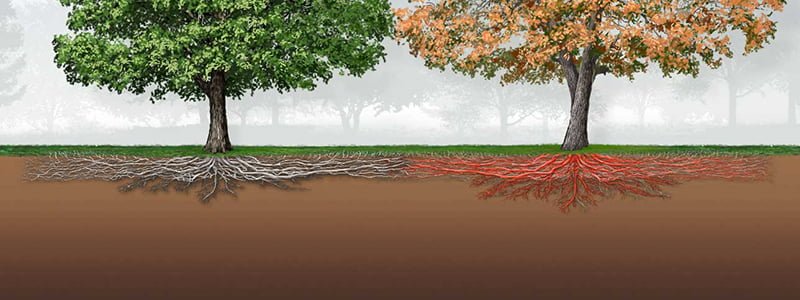Oak Wilt is a tree disease that affects several species of oak. Killing thousands of oaks each year, it is one of the most serious tree diseases in the Eastern U.S. Infected oaks can be found in forests, woodlands, and within homeowners’ landscapes. The disease is formally known as Ceratocystis Fagacearum, which is a fungus that develops in xylem (the vascular tissue in plants that carries water and nutrients up from the tree’s roots).
What will be covered in this blog post: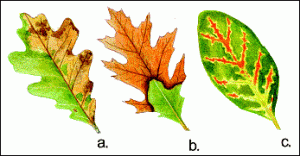
- Oak Wilt’s origin
- Symptoms
- How it is spread
- Prevention
- Management and control of existing infections
When was the Oak Wilt first discovered?
Research suggests that oak wilt originally arrived in North America in the early 1900s but was not initially discovered until 1944. In the early stages of discovery, due to complications with isolation and identification of the fungus, the full extent of the impact Ceratocystis Fagacearum had on oak trees was not understood until the 1980s. Although Oak Wilt has not officially spread to our Upstate NY area, it continues to get closer, with a recent Oak Wilt detection in Brooklyn in 2016 (this is the fourth county in NY that Oak Wilt has been confirmed in).
Symptoms of Oak Wilt:
Oak Wilt develops, progresses, and looks a bit different in each oak group.
- Red Oak (have fan-shaped leaves with sharply pointed tips)
- Rapid leaf discoloration (initially shift will be subtle off-green coloring)
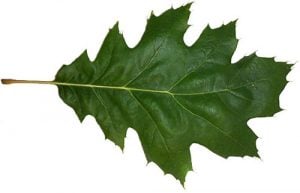
- Look for this discoloring in late June – early July
- After the initial color shift, leaves may begin to wilt from the top of the crown downward.
- Usually infected trees will be entirely leafless within a few weeks.
- In some instances, diseased oaks may display a brown substance on the outer ring of vessels visible in cross sections. This will often be difficult for an untrained eye to identify.
- Rapid leaf discoloration (initially shift will be subtle off-green coloring)
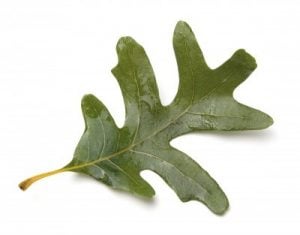 White Oak (have fan-shaped leaves with rounded or blunt tips)
White Oak (have fan-shaped leaves with rounded or blunt tips)
- Die at a much slower rate, often one branch at a time
- Leaf wilting will look similar to that of the infected red oak.
- Brown streaking in the outer growth rings is often quickly visible, even to an untrained eye.
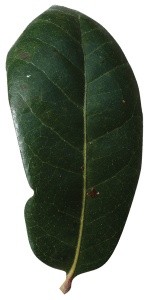 Live Oak (have oval leaves with pointed to rounded tips)
Live Oak (have oval leaves with pointed to rounded tips)
- Decline can be rapid or slow depending on timing of infection and the weather conditions.
- Leaves develop yellow veins that will then turn brown (called Veinal Necrosis).
- These leaves will eventually fall off.
- Tree crowns will thin until the tree’s death (usually takes anywhere from 1-6 months).
How Oak Wilt is spread:
The fungus that causes Oak Wilt can spread from tree to tree in two ways:
- Underground through roots – The roots of oak trees commonly latch on to roots of other trees in the same group creating a sort of underground community. Meaning, if one tree becomes infected, this infection can easily be passed through the roots from one tree to the next.
- By insects – The fungus can also be carried/spread from tree to tree by insects when bugs move from an infected tree to a fresh wound on a healthy tree. Nitidulid beetles (also known as sap beetles) are the primary bug responsible for the spreading of Oak Wilt. These types of bugs are attracted to open tree wounds from storms, construction, and/or pruning because fresh cuts leak sap. Oak Bark beetles are another culprit that may carry and spread Oak Wilt.
Prevention:
A designated health plant care plan is the best way to help prevent infection to your oaks.
Management:
Oak Wilt can be managed to prevent new infection centers, and limit its expansion and spreading. Once an oak has become infected, there is no known chemical treatment that can fully cure the disease. However, the development of new Oak Wilt infections and spores can be avoided by removing dead or diseased trees and limiting tree injury to surrounding healthy trees to avoid Oak Wilt spread from insects. At this point, hiring a professional to disrupt the underground connection between the trees in your yard is a smart plan of action to avoid infection that is spread through root systems.
If a tree has died from Oak Wilt, it should be removed and undergo proper treatments at the site to avoid development of new infections. For tree removal services and treatments, please contact a professional arborist like the trained staff at Red Cedar.
Although Oak Wilt has not yet been confirmed in our local area, if you are concerned that your oak trees may be displaying any of the symptoms listed above, schedule an inspection immediately. Proper treatment begins with the right diagnosis! If your oaks are not displaying any symptoms and you believe they are healthy, putting together a proper care plan and insect control plan to prevent any future infections is extremely important.


